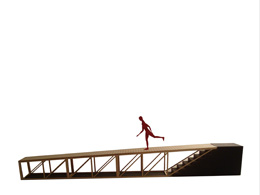STUDENTS PROJECTS
PROJECTS2013

21 May, 2015
Brussels: Eight ground Installations
A sensory approach of the city through walking.
Student name: Tsagkatou Ilenia
Supervisor: Dragonas Panos
University of Patras| Department of Architecture
Date of Presentation: 27 February 2014
The purpose of this study, which revolves around the public space of Brussels, is the realization of Eight Installations, whose aim is to aesthetically transcend the essence of the city to the individual through the everyday wanderings. The conception of the project is rooted in the observations of the human body, on how movement is affected by terrains of different quality, and the various transitions.
The method followed for the initial data collection, was the observation of the city centre during simple walking experiences. Through the process of cartography, the Eight Installation areas were selected and thus a new city map was created.

The result is an urban trail consisting of areas around the city that are very different though with common characteristic the alteration of their respective terrain conditions and their boundaries. The walking trail offers to the individual a variety of aquatic, aerial, and stable pathways that contribute to a full body experience through the different states of movement such as balance, climbing, jumping, sliding, and the adjustment of the walking pace according to the inclination and the stability of the ground's surface.

The proposed Installations therefore, create sensory appealing experiences through the interaction of the ground's texture with the body movement and balance. It is assumed that movement is mainly affected by the abovementioned interactions rather than the time factor.
The basis of the Installations' structure is consisted of the materials used, the linearity of movement, and the scale of the human body
As far as the design is concerned, 8 wood ground panels were manufactured, each offering a different walking sensation and adjusted to the dimensions of the various designated areas. The new city terrain alterations occur either from their remodelling or by reinforcing the pre-existing characteristics. The purpose of the project, therefore, is to disrupt the compatible urban transition from one place to another.
The following is a brief presentation of the core idea encapsulated in each installation.
1. Climbing
The space of the first installation is a park surrounded by tall buildings. The individual enters the park through a parametric, 3-meter elevated root. The idea is to utilize the vertical element of the wall so as to create climbing installation. The structure is consisted of 6 wooden girders, placed parallel to the wall.

2. Oscillation
The setting is a social housing complex. Vertically on the parallel roads that separate the sub complexes, there are arched arcades leading to ground levels with 1-meter difference. The transition between the two levels is facilitated through a ramp. The idea is the construction of a structure that functions under the principles of a seesaw that uses the body weight as a means of displacement on a horizontal axis.

3. Inclination
The root is through a narrow alley of 1-meter, in-between two tall buildings, at the end of which a ladder leads to a public space. The aim of this installation is the creation of a moderate gradient ramp over the existing ladder. The width of the construction will be confined to the dimensions of the alley.

4. Ascension
Within the city's central park one can find a fenced, undeveloped section with striking terrain texture. It is accessible through two entrances which can be seen as strong transition points (i.e. from a stable pathway to one of coarse surface). For this case, the approach followed was the addition of a wooden ladder for alternating treads, attached to the variant inclinations of the ground. The idea was inspired by the natural way footprints are formed and left behind creating a trail of their own.

5. Jumping
The space chosen is a garden with geometric design vegetation. The garden has pre-existing central roots and vertically to them narrow 1-meter pathways in-between short bushes. The narrow pathways are to be altered by installing bounce treads on springs. The distance between the installations is based on the average stride of an individual.

6. Rolling
The next installation is situated on the square outside of the central Rail Station. There can be found a roundabout with free traffic flows. The proposed installation is a rolling wheel which an individual can use by walking inside of it to facilitate his transition from one place to another.

7. Balance
For the following installation I chose a root through a pedestrian zone, where the continuity of movement is disrupted by empty water tanks 70cm below ground level. The creative aim is to bridge the width difference of the tanks. The structure will be consisting of connected wooden panels joined with an elastic strap in order to a give a sense of balance while walking on it.

8. Floatation
The last installation was inspired by a walk parallel to the canal. Through a ladder, water level is reached and the pathway followed is through a narrow passage under a bridge. The boundaries of the passage are defined by the side wall and the water. For this case, the water element is utilized. Wooden platforms are placed upon floating barrels making the individual experience balance and imbalance while floating in a sense while walking.











